Krebs / citric acid cycle
Pyruvate oxidation
Introduction
Among the four stages of cellular respiration, pyruvate oxidation is kind of the odd one out; it’s relatively short in comparison to the extensive pathways of glycolysis or the citric acid cycle. But that doesn’t make it unimportant! On the contrary, pyruvate oxidation is a key connector that links glycolysis to the rest of cellular respiration.
Overview of pyruvate oxidation
At the end of glycolysis, we have two pyruvate molecules that still contain lots of extractable energy. Pyruvate oxidation is the next step in capturing the remaining energy in the form of \[\text{ATP}\], although no \[\text{ATP}\] is made directly during pyruvate oxidation.
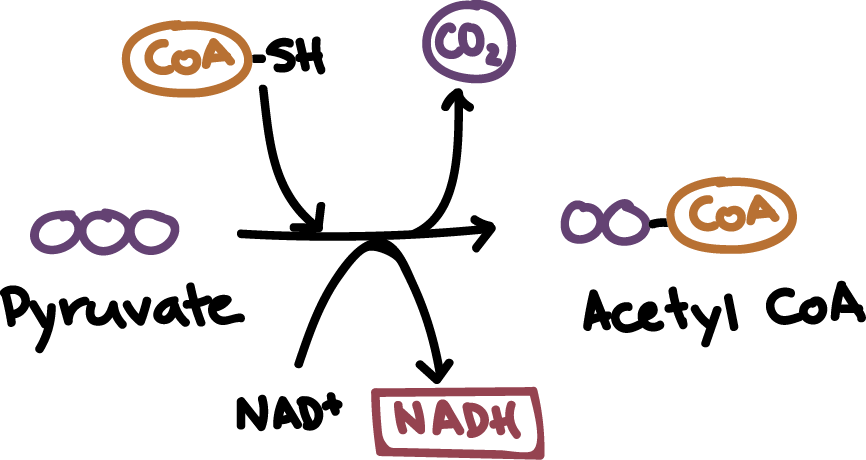
In eukaryotes, this step takes place in the matrix, the innermost compartment of mitochondria. In prokaryotes, it happens in the cytoplasm. Overall, pyruvate oxidation converts pyruvate—a three-carbon molecule—into acetyl \[\text{CoA}\]—a two-carbon molecule attached to Coenzyme A—producing an \[\text{NADH}\] and releasing one carbon dioxide molecule in the process. Acetyl \[\text{CoA}\] acts as fuel for the citric acid cycle in the next stage of cellular respiration.
Pyruvate oxidation steps
Pyruvate is produced by glycolysis in the cytoplasm, but pyruvate oxidation takes place in the mitochondrial matrix (in eukaryotes). So, before the chemical reactions can begin, pyruvate must enter the mitochondrion, crossing its inner membrane and arriving at the matrix.
In the matrix, pyruvate is modified in a series of steps:
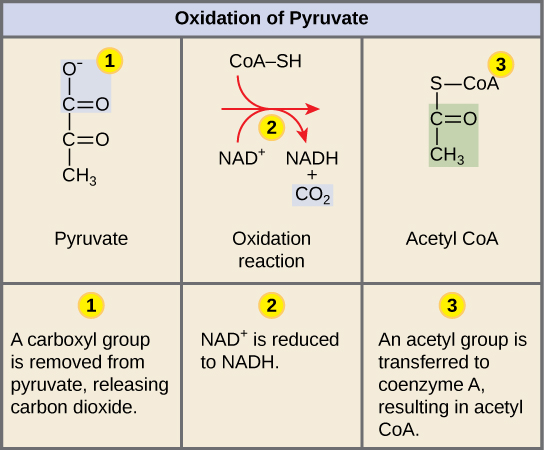
Image credit: "Oxidation of pyruvate and the citric acid cycle: Figure 1" by OpenStax College, Biology, CC BY 3.0
Step 1. A carboxyl group is snipped off of pyruvate and released as a molecule of carbon dioxide, leaving behind a two-carbon molecule.
Step 2. The two-carbon molecule from step 1 is oxidized, and the electrons lost in the oxidation are picked up by \[\text{NAD}^+\] to form \[\text{NADH}\].
Step 3. The oxidized two-carbon molecule—an acetyl group, highlighted in green—is attached to Coenzyme A (\[\text{CoA}\]), an organic molecule derived from vitamin B5, to form acetyl \[\text{CoA}\]. Acetyl \[\text{CoA}\] is sometimes called a carrier molecule, and its job here is to carry the acetyl group to the citric acid cycle.
The steps above are carried out by a large enzyme complex called the pyruvate dehydrogenase complex, which consists of three interconnected enzymes and includes over 60 subunits. At a couple of stages, the reaction intermediates actually form covalent bonds to the enzyme complex—or, more specifically, to its cofactors. The pyruvate dehydrogenase complex is an important target for regulation, as it controls the amount of acetyl \[\text{CoA}\] fed into the citric acid cycle\[^{1,2,3}\].
If we consider the two pyruvates that enter from glycolysis (for each glucose molecule), we can summarize pyruvate oxidation as follows:
Two molecules of pyruvate are converted into two molecules of acetyl \[\text{CoA}\].
Two carbons are released as carbon dioxide—out of the six originally present in glucose.
2 \[\text{NADH}\] are generated from \[\text{NAD}^+\].
Why make acetyl \[\text{CoA}\]? Acetyl \[\text{CoA}\] serves as fuel for the citric acid cycle in the next stage of cellular respiration. The addition of \[\text{CoA}\] helps activate the acetyl group, preparing it to undergo the necessary reactions to enter the citric acid cycle.
The citric acid cycle
Introduction
How important is the citric acid cycle? So important that it has not one, not two, but three different names in common usage today!
The name we'll primarily use here, the citric acid cycle, refers to the first molecule that forms during the cycle's reactions—citrate, or, in its protonated form, citric acid. However, you may also hear this series of reactions called the tricarboxylic acid (TCA) cycle, for the three carboxyl groups on its first two intermediates, or the Krebs cycle, after its discoverer, Hans Krebs.
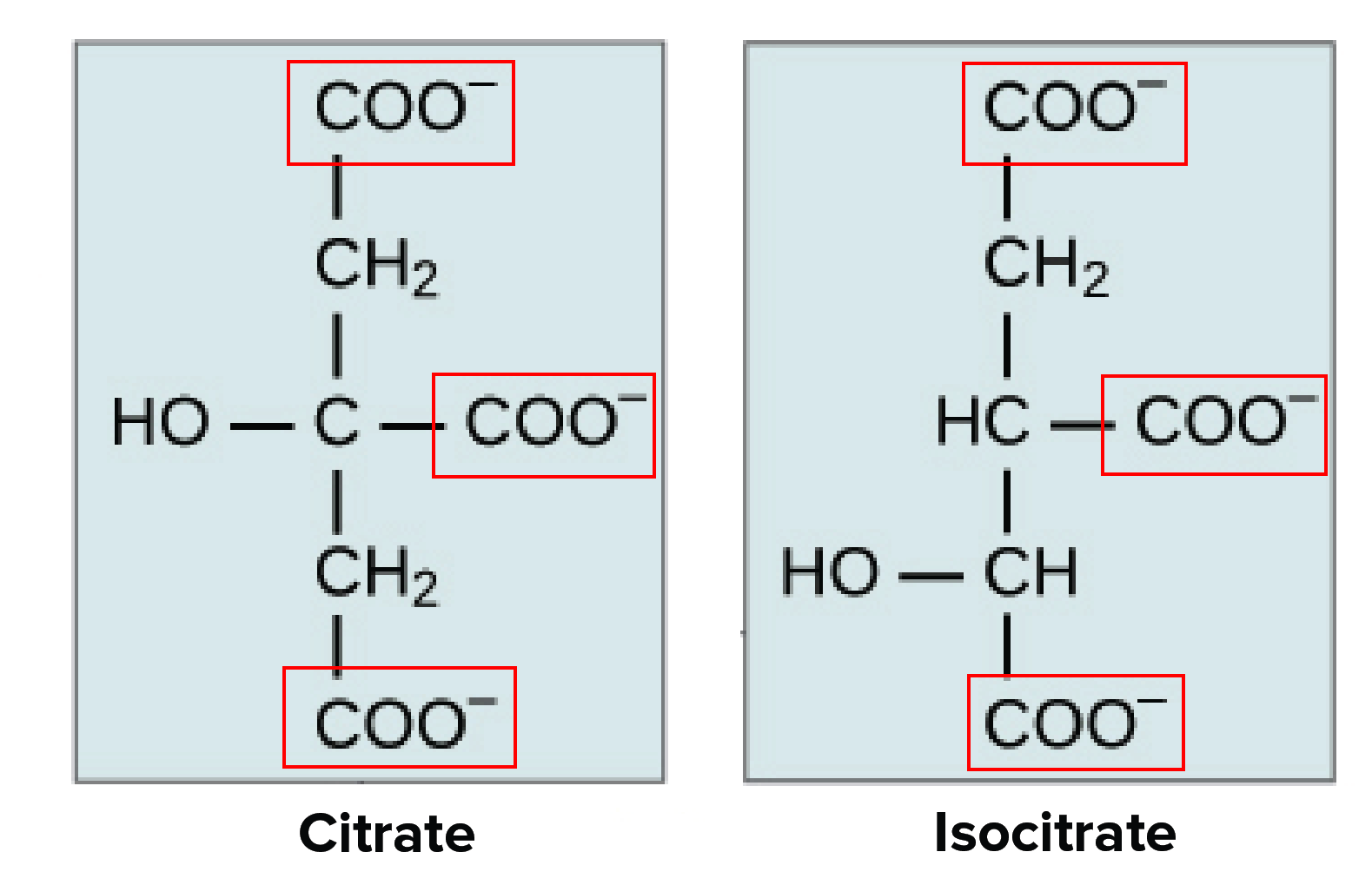
Whatever you prefer to call it, the citric cycle is a central driver of cellular respiration. It takes acetyl \[\text{CoA}\]—produced by the oxidation of pyruvate and originally derived from glucose—as its starting material and, in a series of redox reactions, harvests much of its bond energy in the form of \[\text{NADH}\], \[\text{FADH}_2\], and \[\text{ATP}\] molecules. The reduced electron carriers—\[\text{NADH}\] and \[\text{FADH}_2\]—generated in the TCA cycle will pass their electrons into the electron transport chain and, through oxidative phosphorylation, will generate most of the ATP produced in cellular respiration.
Below, we’ll look in more detail at how this remarkable cycle works.
Overview of the citric acid cycle
In eukaryotes, the citric acid cycle takes place in the matrix of the mitochondria, just like the conversion of pyruvate to acetyl \[\text{CoA}\]. In prokaryotes, these steps both take place in the cytoplasm. The citric acid cycle is a closed loop; the last part of the pathway reforms the molecule used in the first step. The cycle includes eight major steps.
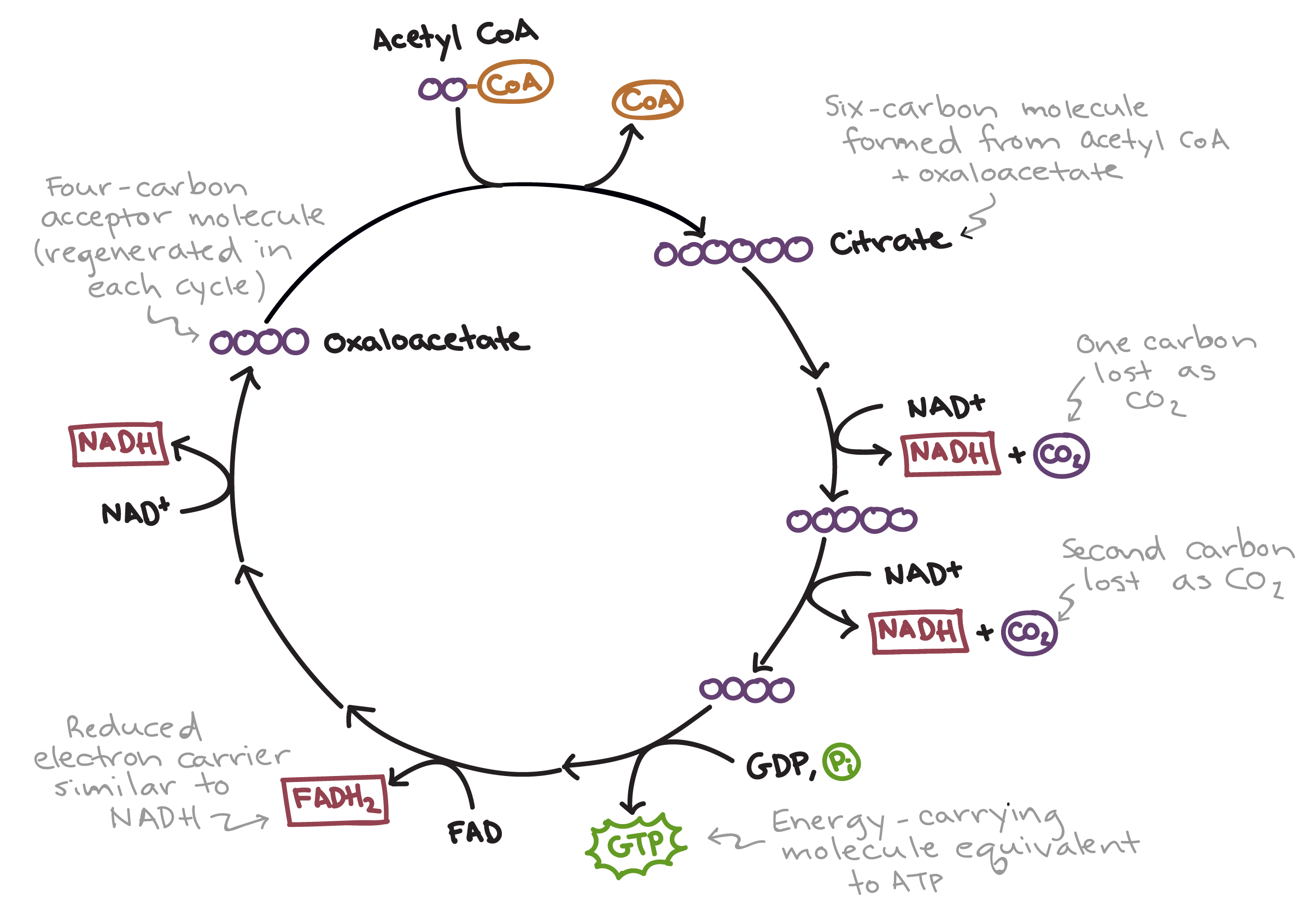
In the first step of the cycle, acetyl \[\text{CoA}\] combines with a four-carbon acceptor molecule, oxaloacetate, to form a six-carbon molecule called citrate. After a quick rearrangement, this six-carbon molecule releases two of its carbons as carbon dioxide molecules in a pair of similar reactions, producing a molecule of \[\text{NADH}\] each time\[^1\]. The enzymes that catalyze these reactions are key regulators of the citric acid cycle, speeding it up or slowing it down based on the cell’s energy needs\[^2\].
The remaining four-carbon molecule undergoes a series of additional reactions, first making an \[\text{ATP}\] molecule—or, in some cells, a similar molecule called \[\text{GTP}\]—then reducing the electron carrier \[\text{FAD}\] to \[\text{FADH}_2\], and finally generating another \[\text{NADH}\]. This set of reactions regenerates the starting molecule, oxaloacetate, so the cycle can repeat.
Overall, one turn of the citric acid cycle releases two carbon dioxide molecules and produces three \[\text{NADH}\], one \[\text{FADH}_2\], and one \[\text{ATP}\] or \[\text{GTP}\]. The citric acid cycle goes around twice for each molecule of glucose that enters cellular respiration because there are two pyruvates—and thus, two acetyl \[\text{CoA}\]s—made per glucose.
Steps of the citric acid cycle
You've already gotten a preview of the molecules produced during the citric acid cycle. But how, exactly, are those molecules made? We’ll walk through the cycle step by step, seeing how \[\text{NADH}\], \[\text{FADH}_2\], and \[\text{ATP}\]/\[\text{GTP}\] are produced and where carbon dioxide molecules are released.
Step 1. In the first step of the citric acid cycle, acetyl \[\text{CoA}\] joins with a four-carbon molecule, oxaloacetate, releasing the \[\text{CoA}\] group and forming a six-carbon molecule called citrate.
Step 2. In the second step, citrate is converted into its isomer, isocitrate. This is actually a two-step process, involving first the removal and then the addition of a water molecule, which is why the citric acid cycle is sometimes described as having nine steps—rather than the eight listed here\[^3\].
Step 3. In the third step, isocitrate is oxidized and releases a molecule of carbon dioxide, leaving behind a five-carbon molecule—α-ketoglutarate. During this step, \[\text{NAD}^+\] is reduced to form \[\text{NADH}\]. The enzyme catalyzing this step, isocitrate dehydrogenase, is important in regulating the speed of the citric acid cycle.
Step 4. The fourth step is similar to the third. In this case, it’s α-ketoglutarate that’s oxidized, reducing \[\text{NAD}^+\] to \[\text{NADH}\] and releasing a molecule of carbon dioxide in the process. The remaining four-carbon molecule picks up Coenzyme A, forming the unstable compound succinyl \[\text{CoA}\]. The enzyme catalyzing this step, α-ketoglutarate dehydrogenase, is also important in regulation of the citric acid cycle.
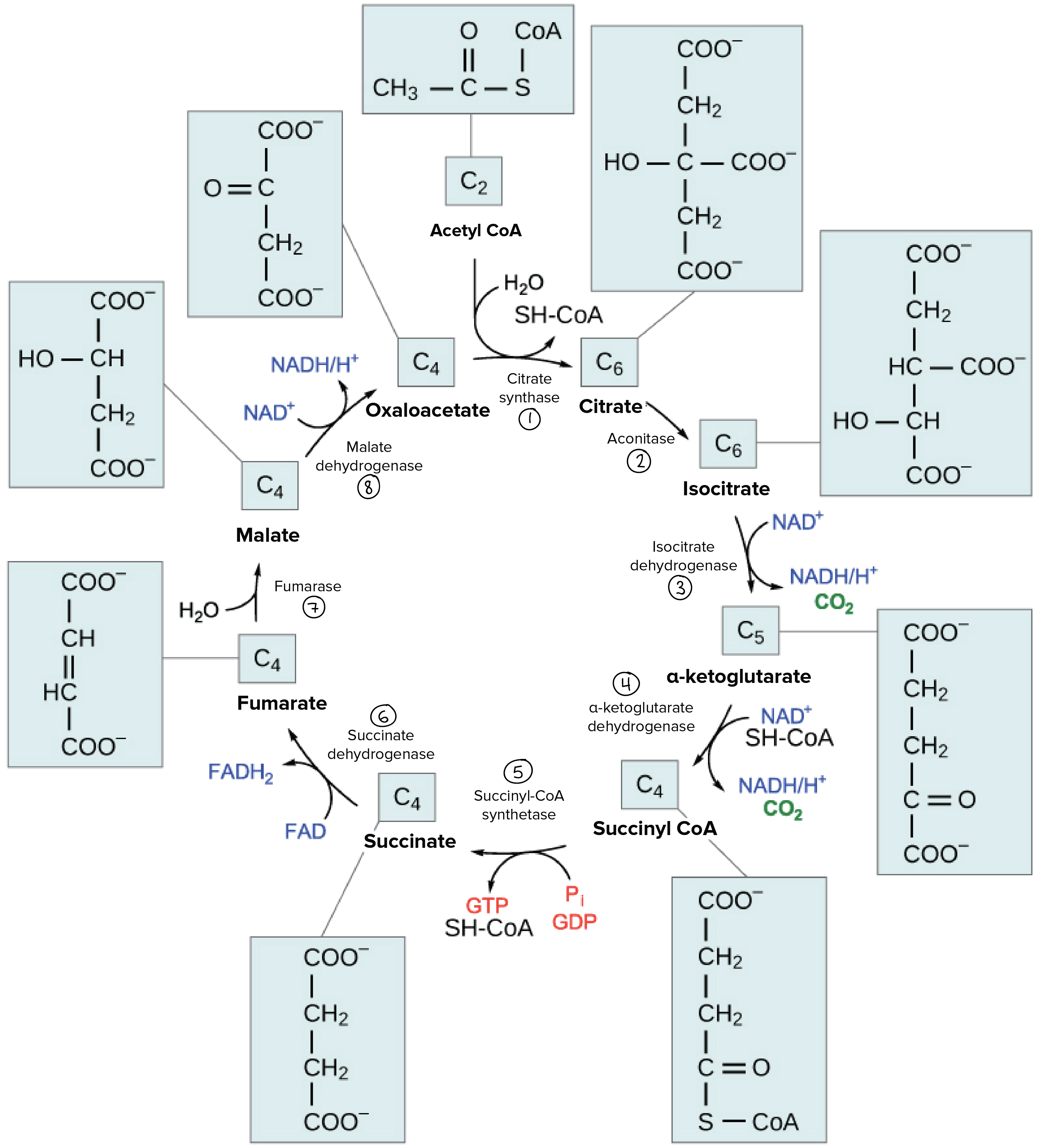
image credit: modified from "Oxidation of pyruvate and citric acid cycle: Figure 2" by OpenStax College, Biology, CC BY 3.0
Step 5. In step five, the \[\text{CoA}\] of succinyl \[\text{CoA}\] is replaced by a phosphate group, which is then transferred to \[\text{ADP}\] to make \[\text{ATP}\]. In some cells, \[\text{GDP}\]—guanosine diphosphate—is used instead of \[\text{ADP}\], forming \[\text{GTP}\]—guanosine triphosphate—as a product. The four-carbon molecule produced in this step is called succinate.
Step 6. In step six, succinate is oxidized, forming another four-carbon molecule called fumarate. In this reaction, two hydrogen atoms—with their electrons—are transferred to \[\text{FAD}\], producing \[\text{FADH}_2\]. The enzyme that carries out this step is embedded in the inner membrane of the mitochondrion, so \[\text{FADH}_2\] can transfer its electrons directly into the electron transport chain.
Step 7. In step seven, water is added to the four-carbon molecule fumarate, converting it into another four-carbon molecule called malate.
Step 8. In the last step of the citric acid cycle, oxaloacetate—the starting four-carbon compound—is regenerated by oxidation of malate. Another molecule of \[\text{NAD}^+\] is reduced to \[\text{NADH}\] in the process.
Products of the citric acid cycle
Let’s take a step back and do some accounting, tracing the fate of the carbons that enter the citric acid cycle and counting the reduced electron carriers—\[\text{NADH}\] and \[\text{FADH}_2\]—and \[\text{ATP}\] produced.
In a single turn of the cycle,
two carbons enter from acetyl \[\text{CoA}\], and two molecules of carbon dioxide are released;
three molecules of \[\text{NADH}\] and one molecule of \[\text{FADH}_2\] are generated; and
one molecule of \[\text{ATP}\] or \[\text{GTP}\] is produced.
These figures are for one turn of the cycle, corresponding to one molecule of acetyl \[\text{CoA}\]. Each glucose produces two acetyl \[\text{CoA}\] molecules, so we need to multiply these numbers by \[2\] if we want the per-glucose yield.
Two carbons—from acetyl \[\text{CoA}\]—enter the citric acid cycle in each turn, and two carbon dioxide molecules are released. However, the carbon dioxide molecules don’t actually contain carbon atoms from the acetyl \[\text{CoA}\] that just entered the cycle. Instead, the carbons from acetyl \[\text{CoA}\] are initially incorporated into the intermediates of the cycle and are released as carbon dioxide only during later turns. After enough turns, all the carbon atoms from the acetyl group of acetyl \[\text{CoA}\] will be released as carbon dioxide.
Where’s all the ATP?
You may be thinking that the \[\text{ATP}\] output of the citric acid cycle seems pretty unimpressive. All that work for just one \[\text{ATP}\] or \[\text{GTP}\]?
It’s true that the citric acid cycle doesn’t produce much \[\text{ATP}\] directly. However, it can make a lot of \[\text{ATP}\] indirectly, by way of the \[\text{NADH}\] and \[\text{FADH}_2\] it generates. These electron carriers will connect with the last portion of cellular respiration, depositing their electrons into the electron transport chain to drive synthesis of ATP molecules through oxidative phosphorylation.
